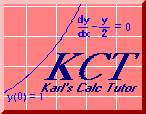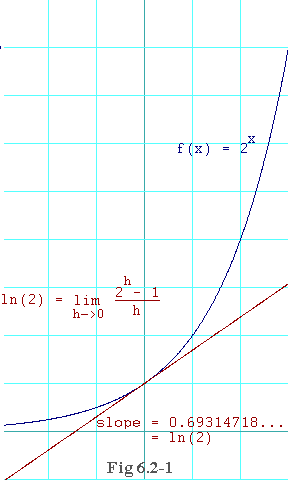

Return now to the example of that bacteria that doubled its numbers every 60 minutes. Remember that after 10 hours, a single bacterium had multiplied into 1024 (that is 210). In the 11th hour, we expected that the population would increase from 1024 to 2048 (that is to 211), for a net increase of 1024.
In fact, in any hour, the net increase is we expect precisely
the amount there were at the beginning of the hour. But what
is the increase we expect in, say, half an hour? If the population
grows in 1 hour to 21 times what it was, then
in half an hour, we expect it to grow to 20.5
times what it was. And from our discussion in the last section,
we know that 20.5 is in fact
(1024 × 1.41421356) - 1024 = 1024 × (1.41421356 - 1) = 424.15What I'd like you to notice is not the 424.15, but the middle expression. Notice that it is the product of the starting amount and
And what about the net increase in a quarter-hour period? We expect
that if there are n at the beginning of the quarter-hour,
then at the end of the quarter-hour there ought to be
Remember also that we determined that if the bacteria colony is allowed
to grow unchecked for several days, the population would grow so large
that cell divisions would be taking place in even the shortest imaginable
time intervals. Still you would find that even over a millisecond, the
net increase in population would continue to be in direct proportion to
the population at the start of that millisecond. One millisecond is
0.0000002778 hours. So if there are n bacteria at
the beginning of a millisecond, there should be
This is the operative property of all exponentials: the rate of increase is always in direct proportion to the exponential itself. And in place of the phrase rate of increase we can substitute the word derivative. We have demonstrated the truth of this informally with our discussion of the bacteria colony. We now go on to demonstrate it mathematically. Warning: The derivation that follows is likely to be on the exam.
Recall from
df f(x + h) - f(x)
f'(x) = = lim eq. 4.1-2
dx h > 0 h
If you wanted to know the derivative of the function
f(x) = 2x eq. 6.2-1for example, you would substitute 2x for f(x) into eq. 4.1-2. Where you see f(x+h) you would substitute 2x+h. And you get
2x+h - 2x
f'(x) = lim eq. 6.2-2
h > 0 h
By taking this limit as h goes to zero, the derivative of
2x should emerge.
But how do you take that limit? First we can apply the basic rule of exponents that we developed in the last section. Notice that we have a term, 2x+h. And recall we had a rule about the sum of exponents.
2x+h = 2x × 2h eq. 6.2-3If you substitute this in for 2x+h, 6.2-2 becomes
(2x × 2h) - 2x
f'(x) = lim eq. 6.2-4
h > 0 h
Notice that the two terms in the numerator have a common factor of
2x. If you factor that out, you get
2h - 1
f'(x) = lim × 2x eq. 6.2-5
h > 0 h
Remember also the product rule for limits (that is, the limit of the
product is equal to the product of the limits). So the above is the
same as
2h - 1
f'(x) = lim × lim 2x eq. 6.2-6
h > 0 h h > 0
Look carefully at the two limits in eq. 6.2-6. The limit on the left has
no x's in it. That means that it is independent of x.
In other words, no matter where you take the derivative of
2h - 1
f'(x) = 2x × lim eq. 6.2-7
h > 0 h
This makes it quite clear that the derivative of
2h - 1
h
h
0.1 0.71773...
0.01 0.69555...
0.001 0.69339...
0.0001 0.69317...
0.00001 0.69314...
0.000001 0.69314...
Table 6.2-1
The table seems to indicate that limit exists for the limit on the right-hand
side of 6.2-7, at least to 5 places beyond the decimal point. Assuming that
it does, we can say that the derivative of
And we needn't restrict ourselves to
2x. Pick any positive real number, b.
You can run the same derivation on
bx+h - bx
f'(x) = lim eq. 6.2-8
h > 0 h
(bx × bh) - bx
f'(x) = lim eq. 6.2-9
h > 0 h
bh - 1
f'(x) = lim × bx eq. 6.2-10
h > 0 h
bh - 1
f'(x) = lim × lim bx eq. 6.2-11
h > 0 h h > 0
bh - 1
f'(x) = bx × lim eq. 6.2-12
h > 0 h
Again, the derivative of
This limit of
bh - 1
lim eq. 6.2-13
h > 0 h
is so important that we give it a special name. We call it
ln(b), which is an abbreviation for natural log of b.
We shall be studying the natural log intensely in the next
section. Perhaps you have already heard of the ln function
before, or perhaps your instructor has approached it in a different
way. That's ok. There are many roads to the ln function,
and in this tutorial I intend to show them all, and more importantly,
why they are all equivalent.
Using this shorthand for the limit
in 6.2-13, we can say that when
f'(x) = bx × ln(b) eq. 6.2-14which is simply the the exponential, bx, times a constant.

Figure 6.2-1 shows a plot of
1) Let a and b be any positive real numbers. Apply the product rule to
f(x) = ax bxto determine its derivative. Use the shorthand, ln(a) and ln(b), where appropriate. Once you have an expression for f'(x), recall the rule you proved at the end of section 6.1 concerning
f(x) = (ab)xWhat special property of ln(ab) can you infer from all this?
2) Use the chain rule to determine the derivative of
f(x) = bcxwhere b is any positive real number and c is any real number. Once you're done with that, observe from our discussion in the last section that
bcx = (bc)xFind the derivative of the right-hand expression above. What other special property of ln(bc) does this suggest? When you are done working this, click here to see the solution.
3) Take everything you did in the second problem and simply substitute the expression, 1/ln(b), for every occurrence you find of c. Take whatever cancellations you can. What unusual and mathematically interesting relationship do you now find between the resulting function and its derivative? When you see an interesting property and you think it's the one I'm after, click here.
4) Use the product rule to determine the derivative of
x2
f(x) = bx
2
where b is any positive real number. When you are done applying
the product rule, you will see that the result has something you can
factor out. Do so. When you are done,
click here to see if you got the right answer.
5) Use the chain rule to determine the derivative of
f(x) = b-x2where b is any positive real number. Make your best effort, then click here to see if you got it right.
6) Let b be a positive real number and let n be a counting number. Suppose you didn't know what a particular f(x) was, but you knew that the equation,
bf(x) = xnalways holds. Use implicit differentiation (which is really just an application of the chain rule) to find the derivative of f(x). Hint: Once you have applied implicit differentiation, there will be a substitution you can make using the original equation for f(x) that will enable you to simplify the result. The simplicity of the final answer will surprise you. Click here when you are done.
Move on to Be Frugal and Add (logrithms)
email me at hahn@netsrq.com